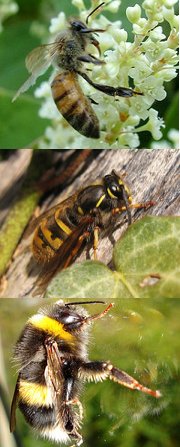For information on what to do if you encounter a swarm, please see our Swarms page.
Honey Bees, or Apis mellifera, are a species of communal insects, who have enjoyed a long history of association with man, due to their usefulness as producers of hive products such as honey and beeswax.
Honey Bees are often confused with Wasps and Bumble Bees, due to similar shared characteristics. However, they are quite easy to tell apart.
Honey bees (top image) are small, pale, and slightly furry. Bumble bees bottom image) are large, fat and very hairy. Wasps (middle image) are a similar size to Honey bees - however wasps are shiny, smooth and much brighter in colour.
Honey Bees live in large colonies - in man-made hives, or in the wild in hollow tree trunks. Honey bees are only aggressive in defence of their hive - they will rarely sting when away from the hive unless threatened or injured. Honey bees can only sting once, and stinging causes the bee to die.
Wasps live in nests, which they construct out of a kind of paper made of wood pulp. Wasps can be very aggressive, particularly in late summer when they often get 'drunk' from eating fermenting fruit fallen from trees. Wasps can sting repeatedly, and thus unlike bees, are more likely to sting people.
Bumble Bees live in small nests - usually in in gaps in stonework or underground. Nests contain around 30 bees. Bumble Bees are very calm, and very rarely sting or cause any problems.

